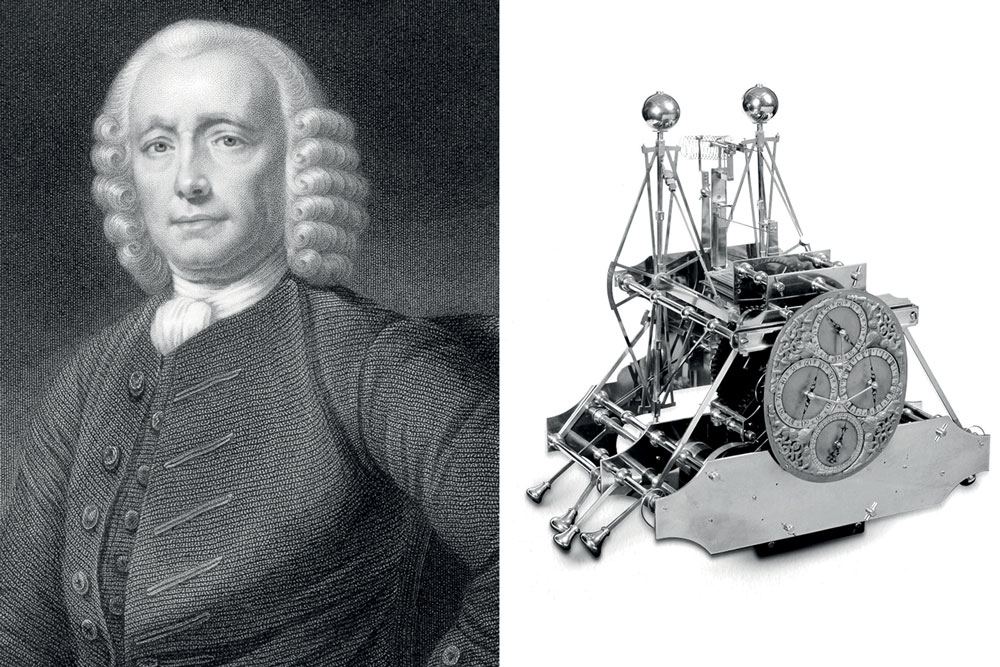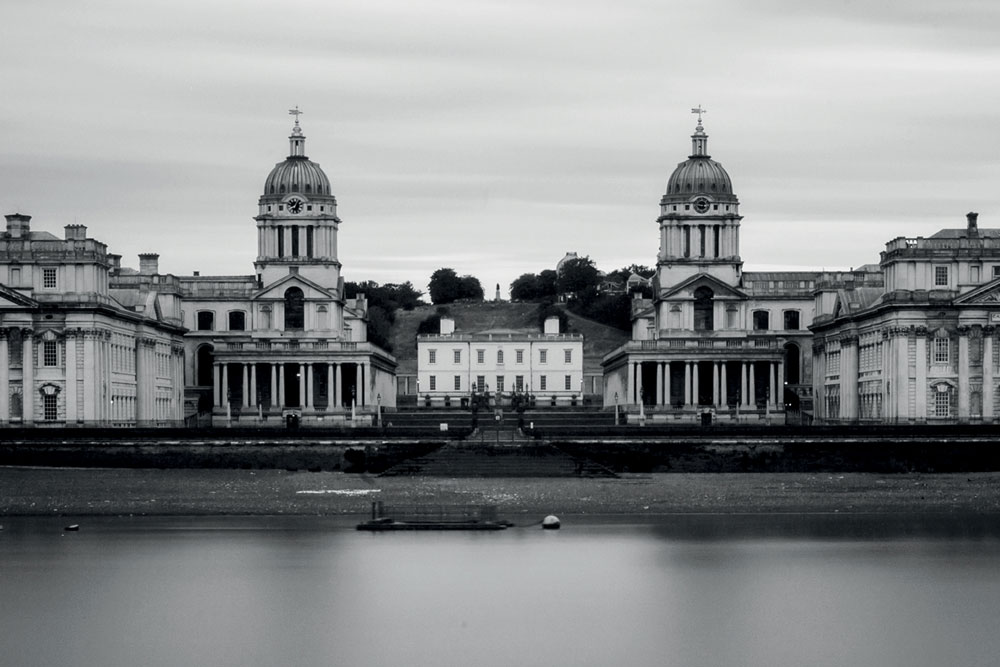THE MARINE CHRONOMETER

“CHRONOMETER MAKING IS AN ART BEYOND CLOCK MAKING. THE VERY FINEST FINISH IS INDEED REQUIRED, AND THE COMPENSATION OF HAIRSPRING TO THE BALANCE OVER A VARIETY OF TEMPERATURES IS THE GREAT CHALLENGE.”
TONY MERCER
ORIGINS OF THE MARINE CHRONOMETER
The development of the marine chronometer is irrevocably linked to the intense rivalry and war among the British, French, Dutch and Spanish in the seventeenth and eighteenth centuries. With the discovery of the New World, the race to conquer new territories was on: dominating the seas meant expanding their empires and protect their trading vessels and increasing the movement of precious metals, manufactured goods, and raw commodities. The key navigational challenge of the time was to accurately measure longitude in order to identify the locations of ships:

DESIGN
The development of the marine chronometer is irrevocably linked to the intense rivalry and war among the British, French, Dutch and Spanish in the seventeenth and eighteenth centuries. With the discovery of the New World the race to conquer new territories was on: dominating the seas meant expanding their empires and protect their trading vessels and increasing the movement of precious metals, manufactured goods, and raw commodities. The key navigational challenge of the time was to accurately measure longitude in order to identify the locations of ships:
JOHN HARRISON AND
THE LONGITUDE PRIZE
It was known throughout the corridors of the various governments that the nation which could create a high-precision chronometer for ships would have dominion over the seas. Unable to accurately plot their position, many ships in fact foundered during the early 18th century. For this reason, in 1714, the British Parliament established the Board of Longitude and offered the Longitude Prize to anyone who could devise a method to determine a ship’s longitude. The solution was found by John Harrison, who spent over 30 years developing and refining his Marine Timekeeper. In 1761 he finally succeeded in creating a chronometer which was accurate to less than half a degree and the Board of Longitude awarded Harrison the £20,000 prize.

JOHN HARRISON AND THE LONGITUDE PRIZE
It was known throughout the corridors of the various governments that the nation which could create a high-precision chronometer for ships would have dominion over the seas. Unable to accurately plot their position, many ships in fact foundered during the early 18th century. For this reason, in 1714, the British Parliament established the Board of Longitude and offered the Longitude Prize to anyone who could devise a method to determine a ship’s longitude. The solution was found by John Harrison, who spent over 30 years developing and refining his Marine Timekeeper. In 1761 he finally succeeded in creating a chronometer which was accurate to less than half a degree and the Board of Longitude awarded Harrison the £20,000 prize.
BRITISH SUPREMACY
By the mid 1800s chronometers, along with sextants and nautical almanacs, were widely available and charting of the oceans had been done on a grand scale. These remarkable instruments enabled explorers and the Royal Navy to map the world, the Navy to police it, and merchant venturers to sail in relative safety.
Its use as a navigational aid for ocean-going vessels, was gradually extended to surveying, medical and other activities calling for precise time measurement. This supported Britain’s territorial expansion, improved trade, communication and knowledge of the world. It is no exaggeration to regard the chronometer as one of the foundation stones of the British Empire.

BRITISH SUPREMACY
By the mid 1800s chronometers, along with sextants and nautical almanacs, were widely available and charting of the oceans had been done on a grand scale. These remarkable instruments enabled explorers and the Royal Navy to map the world, the Royal Navy to police it, and merchant venturers to sail in relative safety.
Its use as a navigational aid for ocean-going vessels, was gradually extended to surveying, medical and other activities calling for precise time measurement. This supported Britain’s territorial expansion, improved trade, communication and knowledge of the world. It is no exaggeration to regard the chronometer as one of the foundation stones of the British Empire.
THE GREENWICH TRIALS
From 1822, the Royal Observatory at Greenwich became responsible for testing, rating and certificating chronometers issued to the royal navy. Success in these trials brought rich rewards. As the ultimate test of chronometry, the annual Observatory Trials could be lucrative to winning manufacturers. Success led to public and private contracts, and even permission to inscribe ‘Maker to the Admiralty’ on the dial of the chronometers. Thomas Mercer gained first place in the 1911 trial, with an 8-day chronometer then purchased by the Astronomer Royal for the Greenwich Observatory.

THE GREENWICH TRIALS
From 1822, the Royal Observatory at Greenwich became responsible for testing, rating and certificating chronometers issued to the royal navy. Success in these trials brought rich rewards. As the ultimate test of chronometry, the annual Observatory Trials could be lucrative to winning manufacturers. Success led to public and private contracts, and even permission to inscribe ‘Maker to the Admiralty’ on the dial of the chronometers. Thomas Mercer gained first place in the 1911 trial, with an 8-day chronometer then purchased by the Astronomer Royal for the Greenwich Observatory.
STANDARD GREENWICH MEANTIME
The chronometer allowed, for the first time, absolutely precise charting of the oceans, thus enabling the establishing of safe and rapid shipping routes. By the mid nineteenth century, all British shipping would take Greenwich as its point of reference for time, and therefore for longitude. By then, virtually all the oceans of the world had been mapped by British ships using as a basis of the Greenwich Meridian – and these maritime charts were widely used by the international community. As a result, both Greenwich Meantime and the Greenwich Meridian were gradually adopted by more and more countries until, in 1884, the Washington Convention formally ratified the practice as effectively universal.

STANDARD GREENWICH MEANTIME
The chronometer allowed, for the first time, absolutely precise charting of the oceans, thus enabling the establishing of safe and rapid shipping routes. By the mid nineteenth century, all British shipping would take Greenwich as its point of reference for time, and therefore for longitude. By then, virtually all the oceans of the world had been mapped by British ships using as a basis of the Greenwich Meridian – and these maritime charts were widely used by the international community. As a result, both Greenwich Meantime and the Greenwich Meridian were gradually adopted by more and more countries until, in 1884, the Washington Convention formally ratified the practice as effectively universal.
THE THOMAS MERCER LEGEND
Thomas Mercer marine chronometers are revered in British maritime history and are most famously linked to Shackleton’s trans-Antarctic expedition (1914-1916). After his ship Endurance became trapped in the ice and destroyed, Shackleton managed to lead his 27 crewmen to safety – using his Thomas Mercer chronometer (now on permanent display at the National Maritime Museum in Greenwich) during the open boat trip on the James Caird. When Francis Chichester embarked on the Atlantic Challenge he relied on a Thomas Mercer marine chronometer. Skippers of notable vessels, including the Royal Yacht Britannia, depended on our timekeepers. Winston Churchill’s private aircraft boasted a Thomas Mercer clock, and so his presidential suite on the Queen Mary. The story of British marine navigation is the story of Thomas Mercer.

THE THOMAS MERCER LEGEND
Thomas Mercer marine chronometers are revered in British maritime history and are most famously linked to Shackleton’s trans-Antarctic expedition (1914-1916). After his ship Endurance became trapped in the ice and destroyed, Shackleton managed to lead his 27 crewmen to safety – using his Thomas Mercer chronometer (now on permanent display at the National Maritime Museum in Greenwich) during the open boat trip on the James Caird. When Francis Chichester embarked on the Atlantic Challenge he relied on a Thomas Mercer marine chronometer. Skippers of notable vessels, including the Royal Yacht Britannia, depended on our timekeepers. Winston Churchill’s private aircraft boasted a Thomas Mercer clock, and so his presidential suite on the Queen Mary. The story of British marine navigation is the story of Thomas Mercer.
AUTHENTICITY
Tony Mercer, grandson of our founder, wrote the definitive work ‘Chronometer Makers of the World’. We are therefore well-placed to judge the authenticity of our chronometers. Parts of our company archives are held in the Horology Collection at the Liverpool World Museum and we carefully conserve all records. With this store of information, we are happy to confirm any Thomas Mercer chronometer’s year of manufacture and other relevant facts.
“The way in which the integrity of the Thomas Mercer name has been maintained is impressive. I am confident in saying that my grandfather Tony would have been proud to know that his family company is at the forefront of the 21st Century and beyond.”
JOEL MERCER

AUTHENTICITY
Tony Mercer, grandson of our founder, wrote the definitive work ‘Chronometer Makers of the World’. We are therefore well-placed to judge the authenticity of our chronometers. Parts of our company archives are held in the Horology Collection at the Liverpool World Museum and we carefully conserve all records. With this store of information, we are happy to confirm any Thomas Mercer chronometer’s year of manufacture and other relevant facts.
“The way in which the integrity of the Thomas Mercer name has been maintained is impressive. I am confident in saying that my grandfather Tony would have been proud to know that his family company is at the forefront of the 21st Century and beyond.”
JOEL MERCER
